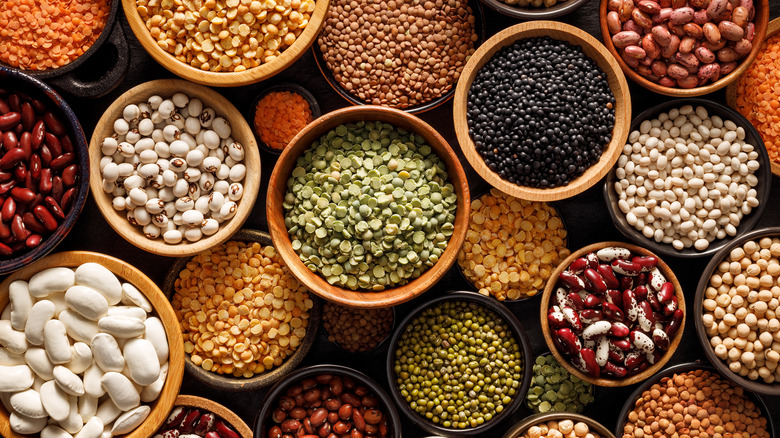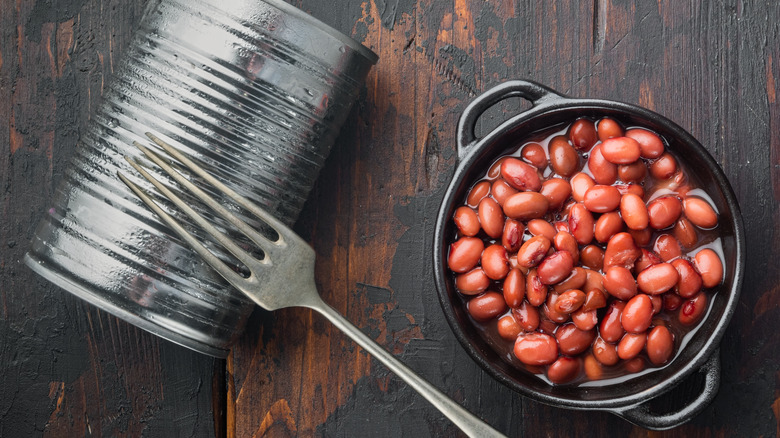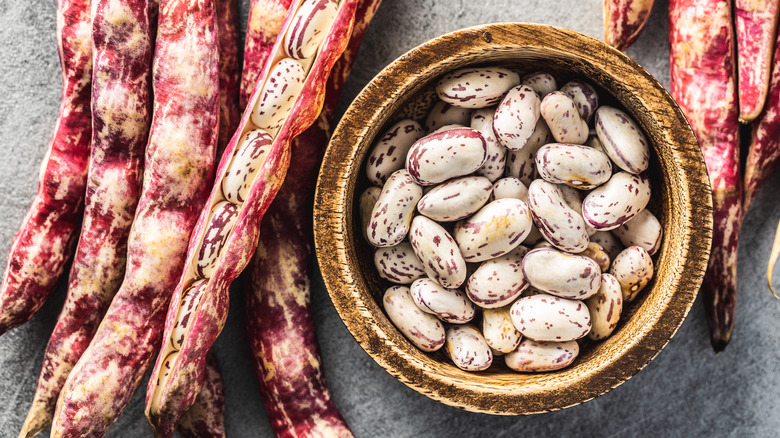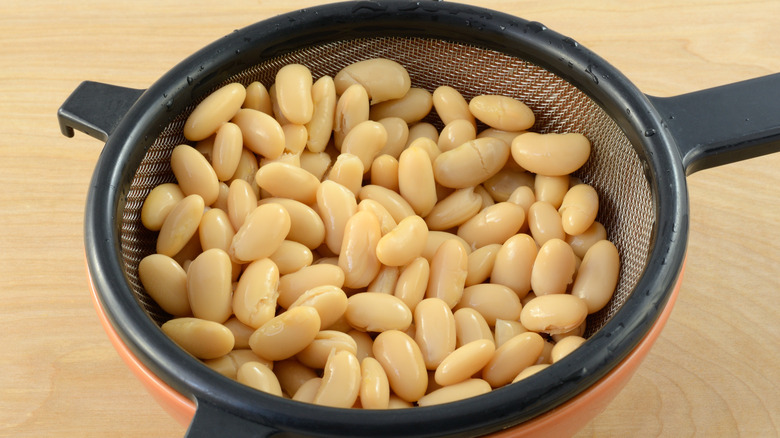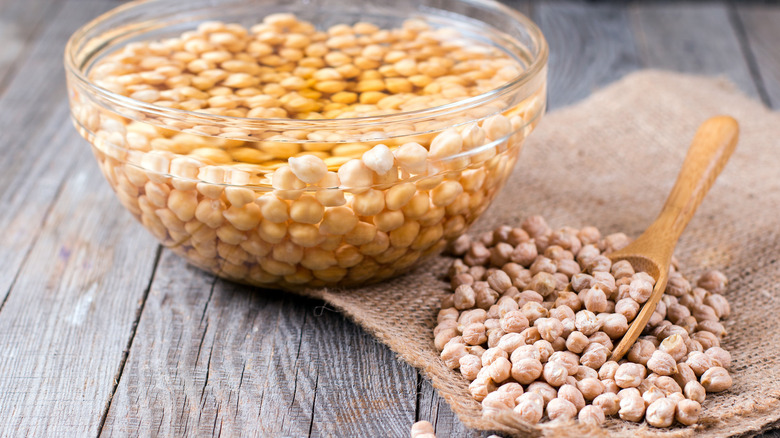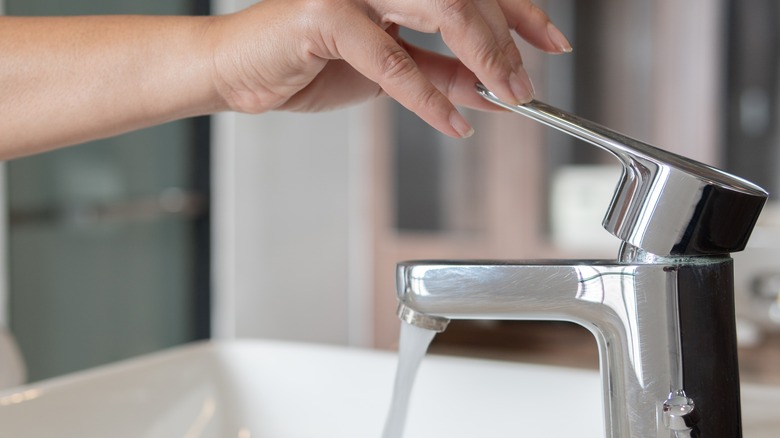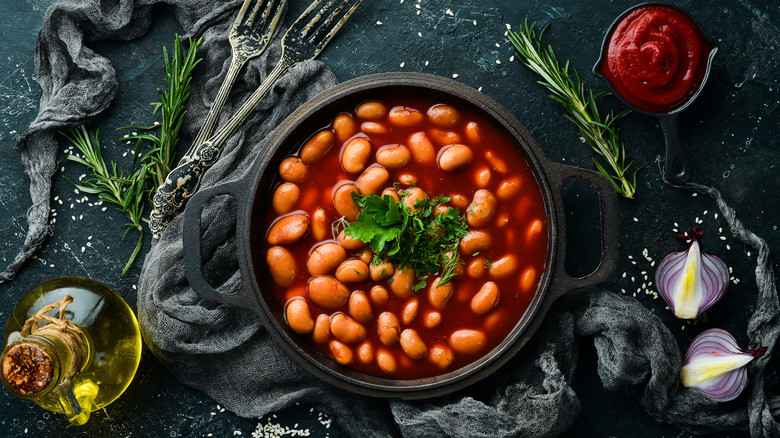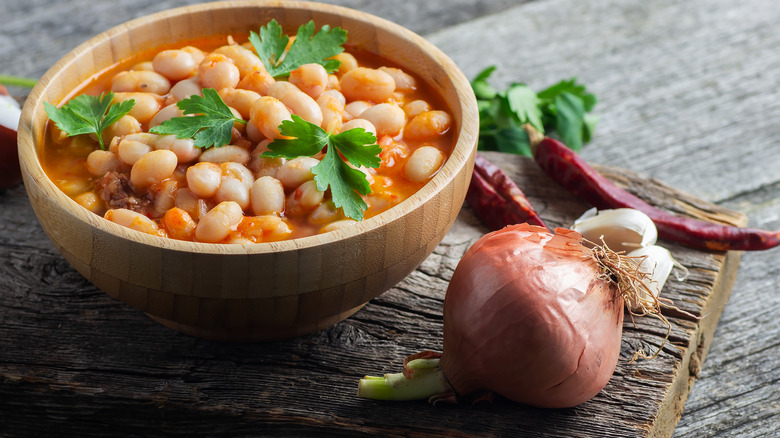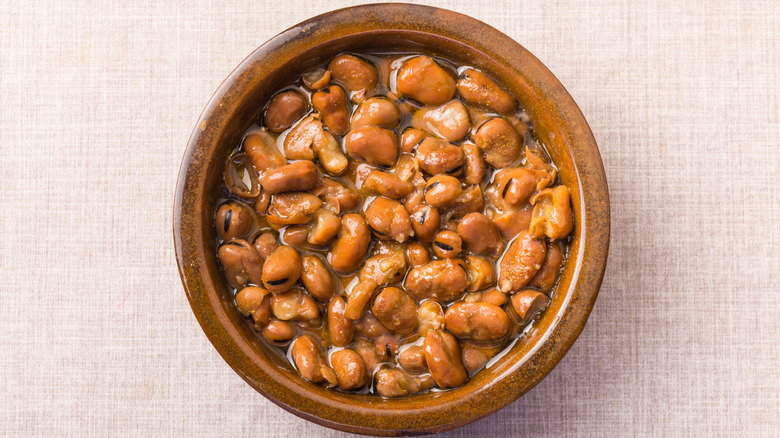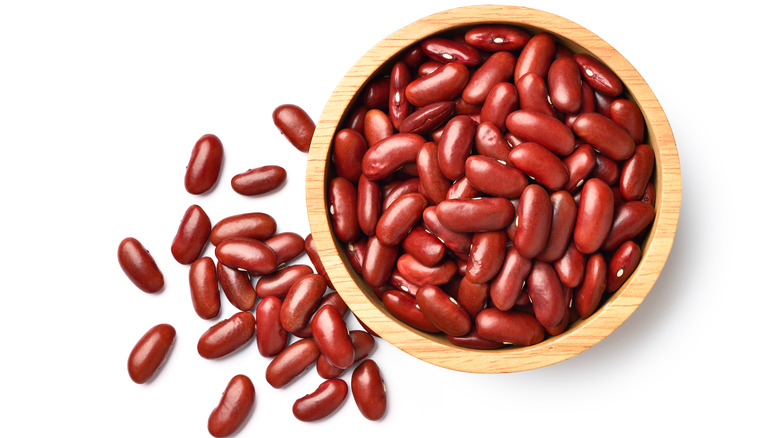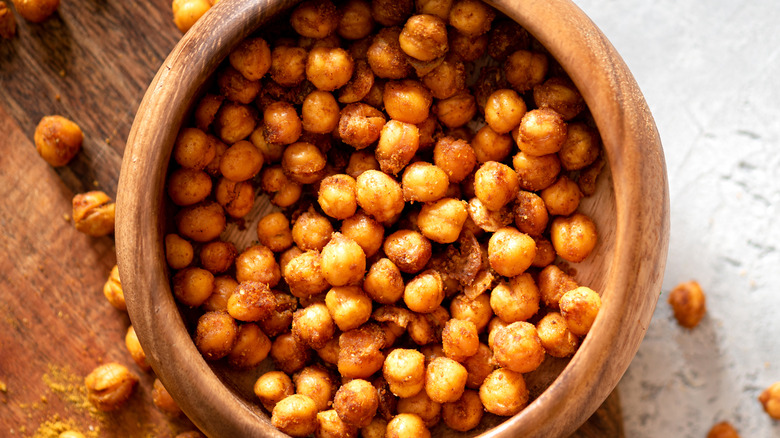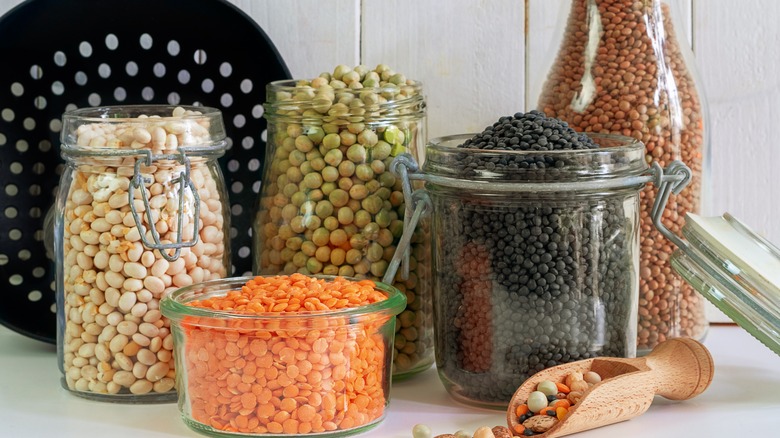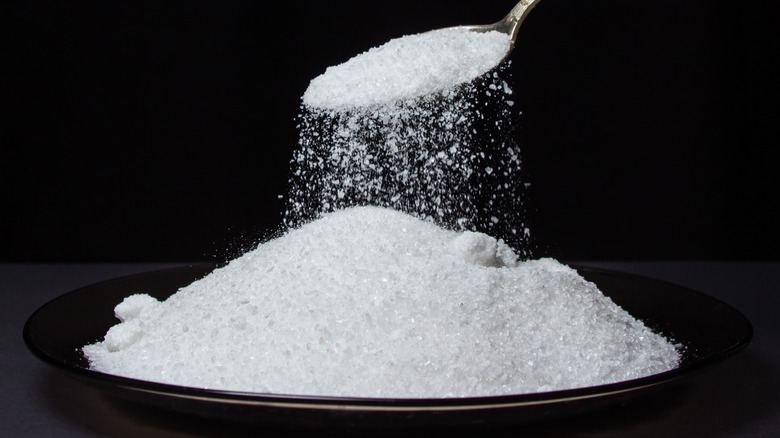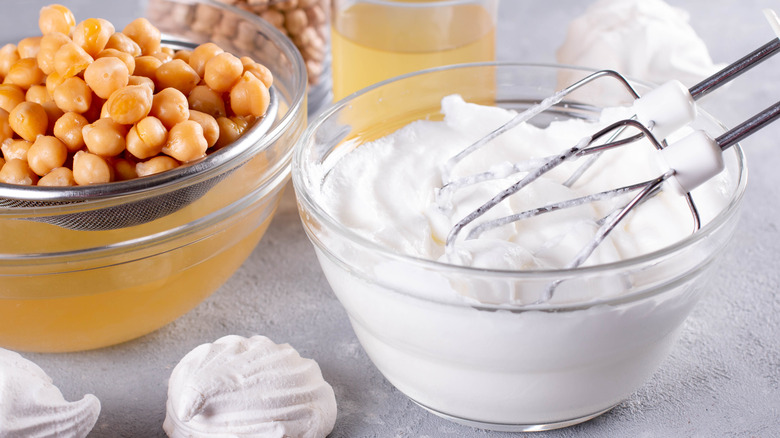13 Common Mistakes Everyone Makes With Beans
Beans are a member of the pulse (also known as grain legume) family. Whether you go for canned or dried versions, beans are one of the most widely available and affordable foods on the market. A great source of protein, they also have a long shelf life, making them a pantry staple. If you eat beans every day, you can help build your muscles with this low-fat protein source. According to Healthline, beans contain 12 to 19 grams of fiber per cup (depending on the variety), which accounts for about half of the daily recommended intake. This is significant, given that the average American only consumes about half that amount (via UCSF Health). Sure, you run the risk of increased flatulence, but you can reduce that by pre-soaking your beans before cooking.
Since they seem like such an easy food to prepare, you may wonder how you could possible screw up cooking with beans. Despite their humble nature, there are a lot of ways things could go wrong. Before you stock up your pantry with legumes, make sure you understand these common mistakes people make with beans so you can prevent easily avoidable errors when preparing them.
Only eating canned beans
Canned beans are certainly convenient, so it is understandable why people often turn to them for everyday cooking. Grocery stores are lined with cans of legumes, which make for an instant protein source for any meal at a great price (especially when compared to animal-based proteins). While canned beans have their benefits, there is a good reason why you should be buying dried beans instead of canned ones.
Dried beans are even more affordable and much lower in sodium than canned beans. According to the National Library of Medicine, dried beans are also rich in fiber and antioxidants, and are known to reduce the risk of ischemic heart disease and diabetes. Some even prefer the taste of dried legumes over canned varieties.
Dried beans do take some added steps, so make sure to plan accordingly and follow the guidelines when you cook with them, in order to skip some very common bean blunders.
Sticking to one type of bean
Humans can easily get stuck in routines. After all, it's comfortable to stick with what you know. When it comes to beans, a lot of people consume the same couple types of beans over and over again. Among the most popular types of beans are black, kidney, and cannellini beans. While we certainly do love the classics, there are over 400 known varieties of beans cultivated around the world (via Ontario Beans).
One type of bean worth trying is the cranberry bean. Also known as borlotti beans, these pink-speckled legumes can be found fresh in-shell in late summer and early fall or dried throughout the year (via James Beard Foundation). These beans have a lovely nutty flavor, and are commonly used in Italian dishes despite being native to Colombia. Another bean to consider is the Anasazi bean. A trademark product of Adobe Milling, Anasazi beans have indigenous ties to the Navajo people of the American Southwest. Unlike most dried beans, Anasazi beans do not need to be pre-soaked and are fairly quick-cooking, making them a great choice when timing is tight.
Not rinsing canned beans
Sometimes, popping open a can of beans is just the best option, especially if you forget to pre-soak dried beans. If you are going to choose canned beans, though, there is one step you never want to skip.
For the best results, you should always rinse canned beans. Canned legumes have a viscous liquid that contains added preservatives to extend the shelf life. Once beans are cooked, they can only be kept safely in the fridge for 3 to 4 days, so the preservatives are necessary to make this a shelf-stable product (via the University of Maine). The liquid, which is primarily water and salt, becomes thick and cloudy because of the starch imparted from the beans.
This liquid is completely edible, but it may not be the most pleasant to consume since canned beans have a high amount of sodium. Even if you are not watching your sodium levels, the added salt can make whatever you cook taste too salty. By draining and rinsing canned beans, you can better control the saltiness of your meal.
Not rinsing and soaking dried beans
It used to be a given that you always needed to soak dried beans before cooking them. However, if you bought them recently, you may not need to soak your dried beans. If you have older beans in your pantry, they will have dried out enough to need that soak time. Soaking your beans in general, though, will ensure your beans cook more quickly. The Mayo Clinic also notes that soaking can make beans easier to digest, because it starts to break down those complex sugars. You can soak beans covered with water overnight, or you can do the quick-soak method. This technique involves covering a pot of beans with water and bringing them to a boil. Then, remove from heat and cover to let sit in the liquid for at least one hour before proceeding with cooking.
Many people mistakenly think that because you soak dried beans, you don't have to rinse them beforehand. However, packaged beans can still have some grit on them. Rinse dried beans in a colander before soaking them, because they may contain some field dust and dirt. Also make sure to sort the beans and look for any stray pebbles and twigs that may have been missed during sorting at the processing facility.
Cooking with hard water
If you pre-soaked your beans and still find that they are not softening, it may be because you are cooking them in hard water. According to Whirlpool, a whopping 85% of homes in the United States have hard water, which contains high levels of calcium and magnesium.
When you cook beans in hard water, it can drastically increase the cooking time. The calcium and magnesium bond with the cell walls of the beans, causing them to harden. If your water is particularly hard, no matter how long you cook the beans, they might retain the tough, chewy texture.
If you don't want to pay for a water softener, salt can be a good solution. Adding salt to the water before cooking can help limit the damage from the hard water. Using salty water in the pre-soak can also prevent the chemical reaction, because the beans slowly absorb the water.
Using acidic ingredients when cooking beans
A lot of bean recipes include flavor boosters from ingredients like tomatoes, wine, or lemon juice. If you don't use them correctly, however, it can ruin your beans. Similarly to hard water, acidic ingredients can keep your beans from softening. If you add acidic ingredients before the beans finish cooking, they will remain hard and tough. This is because the acid will prevent the pectin in the cell walls of the beans from dissolving (via Salt Sear Savor).
Salt Sear Savor recommends adding acidic ingredients towards the end of cooking, after the beans have had a chance to soften. Alternatively, they suggest cooking acidic ingredients separately before combining with the beans. If you want a tomato sauce for your beans, it might be best to build the sauce and then add the beans once they are finished cooking. The last thing you want is to bite down into a crunchy bean when you are expecting a smooth and tender center.
Not adding aromatics
If you cook beans in just water, you could be missing out on an opportunity for flavor development. Almost all food can benefit from adding aromatics during the cooking process. Cooking dried beans with just salt and water is fine, but they are going to taste rather plain.
The Bean Institute recommends cooking beans with aromatics to get the most flavor out of them. They advise adding onion, garlic, and fresh herbs like rosemary, thyme, or bay leaf. Love and Lemons also suggests adding kombu (dried seaweed), as it can help the beans become more digestible. Plus, it is a unique flavor you don't commonly see in bean dishes. They also mention using frozen herbs or vegetable scraps. This is a great way to get the most use out of your produce.
Whatever aromatics you choose, don't forget to take them out when the beans are done cooking. The easiest way to do this is by tying them in a bundle with twine.
Overcooking your beans
Dried beans tend to take a long time to cook, but that doesn't mean you shouldn't worry about overcooking them. Overcooked beans are perfectly safe to eat, but while they may be edible, they'll be less pleasant to consume.
Signs that your beans are overcooked include them being very soft and mushy. Tender beans are ideal, but if they lack firmness and don't keep their shape, they have probably simmered for too long. Overcooked beans will also start to lose their flavor, leaving a flat taste.
If you overcook your beans, don't fear — you don't necessarily have to throw them out. You can mash them up and add them to a soup to thicken it, or even puree them into a sauce. You'll probably want to add some additional spices or flavor agents, though, since the flavor has likely dulled.
Undercooking your beans
Even worse of a blunder than overcooking beans is undercooking them. Overcooking can detract from the eating experience, leaving your beans bland and lifeless. Undercooking beans, on the other hand, can put yourself at risk of food-borne illness. This is especially true for red beans like kidney beans.
Red beans contain the carbohydrate-binding protein lectin. When eaten raw, lectin acts as a toxin in the body. According to Food Safety News, you can get food poisoning from eating just a few raw or undercooked kidney beans. It is very important to fully cook your legumes to avoid getting sick. Leftover cooked beans should also be stored properly in airtight containers in the fridge to help prevent illness.
When beans are fully cooked, they will be tender but still firm. They will still maintain their shape, and the outer skins should just start to peel back from the beans.
Not drying beans before roasting them
Beans are naturally great in soups and stews. Dried beans cooked by themselves have a stew-like consistency. They are warm, comforting, and enjoyable with their saucy consistency. However, you may sometimes want to experience them in another way, such as having a crunchy shell with a soft interior. Crispy spiced chickpeas make a great snack or salad topper, but you need to take some care to get that texture.
To get crispy legumes, you need to roast them in the oven. It is crucial to always dry the beans before you roast them. If your beans are still wet, they won't be able to achieve the Maillard reaction. This is the chemical reaction that causes foods to brown, which is how they get flavor. You'll want to make sure legumes like chickpeas are well-dried before roasting. To dry your beans, lay them out on a towel and pat them dry before coating in olive oil and spices.
Cooking stale dried beans
We all have those items that have been sitting in our pantry for years. A bag of flour, a bottle of vinegar, maybe even a bag of dried beans. If you want to know whether you can still eat dried beans that have been stored for quite some time, the answer is probably yes, but not necessarily recommended. USAID provides no shelf life for dried beans. That said, it doesn't automatically mean you should eat beans that have indefinitely been stored in your home.
While they say beans can be kept indefinitely, USAID notes that dried beans are best if used within 24 months after being packaged. They advise storing dried beans in a cool, dry place for a minimum shelf life of one year. Dried beans are safe to cook and consume as long as they don't show any obvious signs of spoilage or pests, such as visible bugs, mold growth, or rancid smells. You should toss them in any of these circumstances. Otherwise, the beans can be used, although the longer they are stored, the longer they will take to cook.
Not seasoning properly
Salt is the ultimate tool in cooking, but it can be hard for the novice cook to know how much to use. Too little salt and your food will taste bland and flat, but if you add too much, your dish can become inedible. Finding that balance of salt is the best practice for cooking. When it comes to beans, there are some tricks to making sure they are seasoned properly.
With dried beans, you run the risk of under-seasoning. You'll want to season legumes at every stage. The New York Times recommends adding 2 tablespoons of kosher salt to the water when pre-soaking your beans. You should also season your cooking water and then check the salt levels towards the end of cooking, adding more if necessary. Seasoning in layers can help prevent over-salting the beans.
On the other hand, canned beans already have high levels of sodium. We highly recommend you always rinse canned beans to remove some of the excess salt. Rinsing, however, does not get rid of all of the salt. According to SF Gate, canned beans still have sufficient seasoning after being rinsed. You should not need to add salt back into canned beans for them to be palatable.
Discarding the cooking/canned liquid
One of the easiest mistakes you can make when working with legumes is discarding the liquid either from cooking or from the can, thinking there is no further purpose for it. That liquid can have valuable uses, so we recommend you never get rid of the liquid from canned beans. This goes for the cooking liquid from dried beans as well.
That liquid is packed full of concentrated bean flavor. It can make a great addition to soups or stews, for both flavor and thickening power. If you want to try something a little more adventurous, replace some of the liquid ingredients in a casserole or braise with the liquid from beans. You can get some great richness added to your dishes. Just be sure to keep an eye on seasoning, as this liquid contains salt, especially in the case of canned beans.
Chickpeas produce a particularly special liquid called aquafaba. This humble ingredient has become a central point in vegan baking, after it was discovered the substance works similarly to egg whites. You can use aquafaba in place of eggs in cakes, cookies, and even savory ingredients like mayonnaise. You can even make vegan meringues by whipping up aquafaba with sugar, as you would with egg whites.
